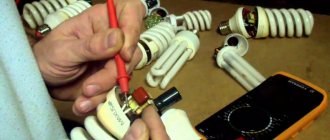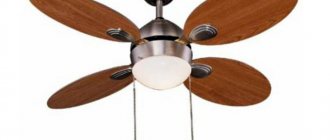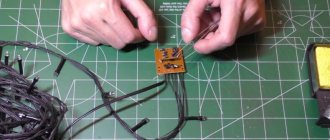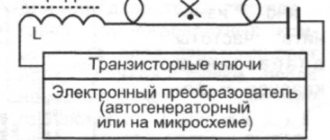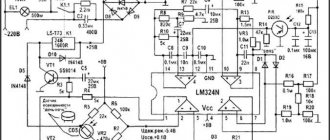Today we’ll look at one of the most common queries on the RuNet - “Chinese garland circuit with LEDs.” I have collected the most common patterns of Chinese-made garlands that are presented on the Russian market. Having such a manual in hand, you can easily cope with any repair of the garland. Of course, due to the fact that garlands have ceased to be a luxury and can be purchased literally for pennies, there is no point in carrying out complex repairs, but it is better to purchase a new one.
The principle of operation of the garland
The electrical circuit of the device is shown in the photo. The voltage from the network is rectified through resistors and diodes, and then supplied to the microcontroller. The capacitor smoothes out network noise. The button in the device in its initial position is in an open state. If it is closed, the controller operating modes change. The latter controls the operation of the thyristors.
After the power passes through the thyristors, it goes to the LED elements of the garland. The number of device outputs directly determines how colorful the display will be. If the garland has two outputs, then this circuit is the simplest. In this case, an alternating color change occurs: some LEDs go out, others light up. The above circuit consists of four channels, which are connected in series with thyristors.
It is worth noting that one of the power conductors is always connected to the outermost LED of each line.
How to make a garland of light bulbs with “running lights”
To create a festive illumination with “running lights” you will need at least 3 garlands, and each of them should consist of several groups of parallel connected “flashlights”. To recreate such a glowing effect, you will need a three-phase multivibrator with transistors, which are designated VT1, TV2 and VT3. A 0.1 µF capacitor is installed in the arm of the second transistor, which greatly simplifies the launch of the product.
You will need a two-half-wave rectifier to power the machine. We are talking about rectifier diodes VD1, VD2, VD3 and VD4. Do not confuse them with LEDs!
This option will allow you to create a wide variety of shapes - from a circle, triangle or square to a heart and thematic figures (snowman, Santa Claus, Snow Maiden, deer in harness).
Remaking a Chinese garland
Most consumers do not have a very good opinion about Chinese products. The garlands also do not stand out against the general background of goods from China: poor-quality connections, too thin conductors, cheap construction materials. As a result, such garlands (including their control units) often fail.
A breakdown of any of the circuit elements can affect the functioning of the garland. For example, a non-working capacitor causes light bulbs to flicker. A thyristor failure entails the shutdown of one of the channels. A burnt-out diode or a failed diode bridge lead to complete system inoperability.
Damaged parts must be replaced with new ones. If you do not have sufficient knowledge in the field of electrical engineering or do not want to bother with repairs, an extremely simple but effective scheme is recommended. We connect the garland directly with a plug, and build a starter from a fluorescent lamp into one of the cable conductors. However, this scheme is only effective for ordinary light bulbs. As for the LED garland, its functionality will be restored in this case, but the light will become dimmer.
Problems and their solutions
Below are the most common breakdowns. You can actually repair the garland with your own hands: this will require attentiveness and accuracy.
Poor soldering quality
Poor soldering of supply and output conductors is the most common cause of backlight failure. In some cases, the contact is held solely by hot-melt adhesive, so its functionality is out of the question. It is enough to lightly touch the conductor, and the contact is completely broken.
Low-quality connections are especially common in Chinese-made garlands. Also, manufacturers from China, in order to save money, often use wires that are too thin, which easily break at the junction with the board.
Another way to avoid wire problems is to avoid stripping wires with a knife. It is easy to excessively thin the wire during this operation. It is better to clean the conductor by heat treatment with a lighter.
LED damage
To find the faulty diode, disconnect the garland from the power supply. We start the test with the last LED in the circuit (the conductor from the power supply goes directly to it). An outgoing wire is connected to the same leg, which goes further to the next branch of the light channel.
You will need to test the LED between a pair of power wires (input and output). As a test device we use a multimeter with slightly modified probes. To upgrade the probes, we attach thin needles to their ends using thread. The point of the needles should protrude just a little - 5-7 millimeters. Apply a layer of insulating tape on top.
Since all the diodes are connected to the circuit by soldering, simply removing them from the lamp (as is the case with a regular garland) will not work. We pierce the insulating layer of the cores to find the copper wires.
Switch the device to LED ringing mode. We begin to pierce the supply conductors near each diode over and over again.
Chaotic flickering
Another common problem is light bulbs flickering randomly. The diodes blink for no apparent reason, their brightness changes chaotically.
The cause of this malfunction is the incorrect operation of the electrolytic capacitor. This element is usually subject to deformation - it looks somewhat bloated.
The way out of this situation is to replace the capacitor. Its nominal value is always written on the body.
If after replacing the capacitor the situation does not improve, the problem may be a burnt-out resistor. Such a defect cannot be detected visually, so in this case you cannot do without a tester. We measure the resistance, not forgetting to find out the rating for the component in advance. If the result obtained does not correspond to the nominal value, change the resistor.
No light in one of the areas
If there is no light at all on any of the channels, this could be due to one of two factors:
- Breakdown on the thyristor or diode of this channel. To make sure that the cause of the malfunction is correctly determined, we unsolder the channel wire on the board and connect a new channel instead of the old one (which definitely works).
- If the above method does not bring a positive result, the problem lies not in the garland, but in one of the board elements - a diode or thyristor. Using a multimeter, we check these components and, if necessary, replace them with working ones.
Dim lighting
There are situations when there is lighting, but one of the channels provides too dim light. In this case, the controller circuit functions without problems, and when pressing the buttons, normal mode switching occurs.
Testing the diodes using a multitester also does not give any results. There is only one possible reason left - poor quality wires. If any part of the stranded conductor is torn, the total cross-section decreases, which is reflected in the dimness of the light. This happens due to the fact that the required amount of voltage is not supplied to the LEDs.
To find a break, you will need to manually check the entire wire line. You will have to be patient, since the defect on the line is quite possibly located on the last thread being tested.
When the problem area is found, we disassemble the conductors on the LED, clean them (preferably with a lighter) and solder them again. Next, we apply an insulating layer using heat shrink.
Broken lamps
If one or more lamps are broken and you decide to repair the garland, it is recommended to simply replace one LED with another. It is technically impractical to repair such light bulbs.
If there is no spare light bulb, remove the broken light source and connect the wires without its participation.
Repair of a Chinese product
Chinese garlands with permanent lamps can also be repaired. Pre-prepared:
- several identical garlands, they will serve as a donor of parts for a damaged product;
- tester;
- insulating tape;
- new lamps;
- wire cutters and a utility knife for working with wires.
The garland is disconnected from the network and the controller is disassembled, the soldering of the wires in the board is checked. Two pads for connecting the power cord are attached to one side, and five for color channels to the second. Moreover, one is located separately from the four; the common wire of all channels is connected to it. After checking the solders, the controller is closed.
Sometimes Chinese products contain lamps that short out when they burn out. This diode has less resistance than other lamps. The faulty part is replaced after de-energizing the garland. All connections must be soldered and insulated with tape. Due to the lack of shorted parts, the entire section of the same color goes out. In this case, check sections of the garland by cutting it in half. The lamp is then replaced, all cuts are connected and insulated.
Don't throw away a damaged Christmas tree garland. All damage can be repaired independently. Also, a broken or burnt-out lamp cannot be short-circuited, since the remaining diodes will begin to receive a higher voltage. This will lead to their burnout. After repairing the product, the entire cord and connections are inspected, and open areas are isolated.
Looking for a break in the chain
What to do if no breaks are found? The design of a Chinese garland is simple. All light bulbs are connected to each other in series. This means that if the blue line does not light up, you need to find at least one burnt out blue lamp. There are two options.
- Check sequentially all elements in the circuit.
- Look for a faulty light bulb by dividing the line in half. Having found the half that does not allow current to pass through, you need to divide it in half again. And so on until a problem is found. After replacing the lamp, all the pieces must be reassembled. It is better to do this with a soldering iron, but you can get by with twisting or electrical tape.
The second method can be avoided if you use a multimeter with thin needles attached to the ends of the probes. However, the conductor strands used in Chinese products are so thin that they can be torn even by a needle.
It happens that you don’t have a second damaged garland or a new light bulb at hand. In this case, you can simply connect the two ends together. This is fraught with an increase in voltage on the remaining light bulbs, since according to the laws of electrical engineering in a series circuit, the voltage is divided equally. But if you remove one or two elements, this will not greatly affect the service life. Despite the fact that the Christmas tree garland designs are Chinese, everything works on general principles.
New Year's garlands
The approaching New Year holiday is always associated with both increased troubles. This cup does not bypass radio amateurs, who begin to puzzle over decorating the Christmas tree with various kinds of light decorations and bright effects. A selection of schematic electrical diagrams of control devices for garlands and other light sources for the New Year holiday is offered.
The circuit of this switch has the illusion of smoothly switching on and off a Christmas tree garland.
Multi-channel garland switch
This machine is capable of controlling eight low-power garlands and provides such effects as running fire, running shadow, flickering and simple chaotic switching.
If any radio amateur decides to repeat these designs, he should pay attention to some errors and inaccuracies in the publication.
Twinkling stars
Perhaps the simplest implementation of the lighting effects of a garland is the use of starters from fluorescent lamps. Just a few details, a minimum of labor, a little diligence, and a joyful mood is guaranteed.
Christmas tree garland switch
The automatic switch circuit for three New Year's garlands on just four microcircuits provides more than a dozen lighting effects: running lights, running shadows, turning on the garlands one at a time, a smooth increase in the glow, blinking all the garlands at once, etc.
Six LED flasher designs
Based on the widely used AL307B red LEDs, simple amateur radio designs can be made. Below are diagrams of flashing lights on transistors and on microcircuits, as well as a diagram of a running light and a running arrow.
?Scheme of the simplest electronic device “running lights” for beginner radio amateurs.
Automatic LED switch
A very simple and interesting device on digital chips for automatically switching LEDs, which can be assembled by any novice radio amateur. In the classic version, this is a machine with the “running fire” effect. But it can easily be turned into a kind of “random number” generator, of which there will be few, however, but four digits.
A simple LED flasher circuit powered by a single galvanic cell.
New Year's garlands (two)
Here we have a diagram of a programmable four-channel automatic lighting effects “running fire”, “running shadow” and two options for switching on garlands in pairs with the ability to change the direction and frequency of channel switching. And also a simple simple arrangement of running lights on garlands of small-sized incandescent lamps with automatic switching of the direction of movement.
Mini-automatic LED lighting effects
A distinctive feature of the given circuit of the machine is the chaotic change of operating modes of the switch, as a result of which there is no eye fatigue and the perception of light effects is improved.
Advantages of LED products
A Chinese garland, the circuit of which is built on LEDs, has a number of advantages.
- Economical. This is due to the low electricity consumption of LEDs. The following two advantages immediately follow from this.
- Durability. The service life of LED products is two or more times longer than the service life of incandescent lamps.
- Safety. LEDs, unlike incandescent lamps, can heat up to a maximum of 60 degrees. Therefore, they are less fire hazardous than their counterparts.
- Brightness. LED garlands are brighter and more pleasing to the eye.
- Frost resistance. LED products can withstand temperatures down to 40 degrees below zero without changes in performance.
- Moisture resistance. These garlands can be used to decorate bathrooms and wet greenhouses.
LED Chinese garlands are very convenient to use to decorate the outdoor part of the house. Due to their high moisture and frost resistance, such products will please the eye for a long time without repair.
Element replacement problem
To replace faulty elements, Chinese colleagues offer their own element base. The problem is that lamps become outdated quite quickly, and finding the right Chinese-made option can be problematic. In this case, the domestic element base comes to the rescue. The most important thing is to choose the right analogue.
To select an analogue of the desired element, it is important to know the parameters of the Chinese product. The PCR406J transistor is often searched for on forums. The Chinese garland, the diagram of which is made on such elements, is familiar. Only the desired element actually turns out to be a thyristor, and its Russian analogue MCR100 is almost identical in parameters.
Scheme of Chinese New Year's garland
The design of a Chinese garland is quite simple, but you need to understand it, because if a breakdown occurs, you can repair it rather than throw away the product. But there will be a breakdown, and there is no need to guess, because the price of a New Year's garland from China is extremely low, which means there is a high chance of a malfunction occurring.
The problem occurs extremely quickly and mainly consists of the disappearance of one of the colors. To know how to repair Christmas tree garlands, you need to familiarize yourself with their diagram.
About decoration
The main bonus of such a New Year's decoration is that it can not only glow with ordinary light, but emit synchronous or chaotic blinking.
Such decoration immediately attracts much more attention. You can choose the appropriate mode, and if you use more than one Christmas tree garland, you can create an entire lighting arrangement.
Controller circuit.
The basis for creating flickering and blinking are microcircuits that have a low degree of integration. The most commonly used models are K155 and K561.
Among them there are also varieties that are designed for different levels of complexity and number of variations.
The main element is a DD2 type counter, which monitors four LED strips.
An interesting fact is that the tempo and sequence of color changes is set by the chip used in synthesizers. Thus, the play of colors in the garland resembles an equalizer.
The simplest version of the garland
Modern designs for New Year's garlands are simple. The simplicity lies in the fact that each color channel operates through a separate generator. That is why, in order to understand the whole scheme, it is enough to understand the principle of operation of one of the colors.
Photo 1. Contents of the Chinese garland controller.
Each color has its own generator, which means they can function separately from each other. However, each of them has its own power level, which makes the flickering process chaotic.
It can be emphasized that when adding white color to the scheme, it will create the impression that the flickering of the colors of the New Year's garlands will occur on a white background.
The peculiarity of New Year's garlands from China is that they are extremely simple and all varieties have the same patterns. Their simplicity is justified by the price of the product, but the quality leaves much to be desired.
Even the minimum price that stores ask for does not justify the real cost of the product. If you evaluate the garland by the elements that are included in it, then the price will not be even 50 cents. It's all about a simple controller that costs a penny. It should be considered in more detail.
Chinese garland controller
If you look from above, it seems that everything is quite simple: an ordinary box with only one button. Having opened that same box, you can find the elements that are shown in photo 1.
Photo 2. Places for soldering wires on the Chinese garland chip.
The controller itself is made in the form of a drop of black solidified substance. There is a control button right next to it. In addition to them, there is an electrolytic capacitor and three outputs for a thyristor.
However, there is a place for a fourth thyristor; when soldered, you can create an additional channel, for example, for the same white color. The channel is also hardwired into the controller, so installing it won't be difficult.
The only point is that with three thyristors, the New Year's garland circuit is even cheaper.
The thyristors, which are included in the circuit of the New Year's garland from China, are quite small in size, while their reverse voltage is 400 V, and the forward current is 0.8 A. With a load of symbolic 25% and a voltage of 220 V, each of them is capable of switching power in 44 W.
It is also necessary to pay attention to the soldering diagram of all contacts. All possible drawings are provided for it
It can be seen in photo 2.
Knowing all these subtleties, you can repair a broken garland or simply expand your knowledge of electronics.
What to do if part of the garland does not light up?
It also happens that one of the channels on the jewelry does not work at all. This defect can be caused by two situations. The first problem is a breakdown on one of the thyristors responsible for the combustion of this section of the garland. In order to test this theory, it is necessary to unsolder the non-working wire, and in its place solder the adjacent one, which is obviously working. If in this case part of the garland still does not work, then the problem is not in the wire, but in the thyristor or diode. The repair in this case is the same as in the previous situation. Using a multimeter, the damaged element is located and replaced with a similar new one.
Soviet style garlands
Garlands produced in Soviet times are reliable. Another feature is that they can be repaired, while not all Chinese-made products can be repaired. Modern devices and tools make it possible to identify faults and carry out repair work.
Required set of tools and materials:
- soldering iron;
- indicator screwdriver;
- insulating material;
- pliers.
The garland uses a serial connection circuit. In other words, if one light bulb burns out, the entire system stops functioning.
We check the lamps for integrity. If the light sources are not damaged, check how they are screwed into the sockets. If necessary, screw the lamp into the socket until the end.
Advice! If you need to replace a colored light bulb, but a replacement is not available, it is recommended to paint the light source with tsapon varnish.
If the steps described above do not give a positive result, take an indicator screwdriver and look for the area where the contact is interrupted in the conductor. The broken contact is not necessarily located in the wire, so we also check the cartridge. If the problem is a broken contact, we restore its functionality using a soldering iron. If necessary, we connect the conductors directly.
Features of LED lamp repair
Correct diagnosis is considered the basis of repair. Most often, it is enough to solder the contacts; in certain cases, the need to replace key components is provoked.
LED lamp repair
If you don't know how to repair an LED lamp, you can study our article and also watch the recommended video that you will find below. Carrying out high-quality repairs, which guarantee the future serviceability of the product and its long-term operation, begins with detailed preparation;
- Dismantling the lamp;
- Studying technical documentation;
- Preparation of instruments (list listed above);
- Purchasing a multimeter to check contacts;
- Carrying out repair work depending on the problem;
- Replacing the driver or power supply if necessary.
LED chandelier repair
- The device is removed from the ceiling or wall;
- The device body is removed;
- The electronic circuit is studied (most often the defects are visible);
- The lampshade and other decorative decorations are removed;
- The light bulbs are unscrewed, the base is diagnosed for burnt areas (cleaning can be done with a simple knife);
- The process of assembling, tightening screws, and checking all contacts is carried out again.
LED strip repair
If the entire strip does not light up, then you need to check the connection of the power supply to the outlet, check the voltage, and carry out the process of analyzing the integrity of the wire. The power supply is being checked. In tapes, it is the power supply that suffers most often, and most often it will simply need to be replaced. If the tape burns partially, then there is a problem with the tracks. Some segments could fail. They can be replaced, this will require a soldering iron and solder.
If the tape flickers - completely or partially, you need to check the power supply, as well as carry out the process of examining the tape for excessive bending. If there is a problem with the unit, it is repaired or replaced; if a certain segment is damaged, the process of replacing the diodes is carried out. If some of the segments are extinguished, but the diodes are intact, this may reflect a problem with the resistor. It is necessary to check the circuit sequentially to find the damaged area and replace it.
Do-it-yourself repair of LED lights and spotlights
Carrying out repairs is standard procedure. A visual inspection is carried out, the housing is removed, and all elements are checked step by step. If necessary, the contacts are cleaned and soldered; in case of serious damage, resistors, diodes, drivers, power supplies, etc. are replaced.
Safety precautions when repairing 220 V LED lamps
Considering that it is necessary to repair a device that operates from the network, it is imperative to observe safety precautions. The lamps we are considering have transformerless power supply; all elements in the device are under voltage during operation, which can pose a threat to life.
Therefore, it is important to observe the following precautions:
- During the soldering process and if necessary to carry out any measurements, be sure to ensure that the lamp is turned off;
- If there are discharge resistors that shunt the capacitors, it is still necessary to manually discharge the capacitors upon completion of the repair. This can be done by short-circuiting the leads of the capacitor using any metal tool that is equipped with a dielectric handle;
- Upon completion of the repair, if the lamp is turned on for the first time, take care of your eyes. In some cases, some elements in the lamp may explode, so it is better to prudently step away or turn away;
- Monitor your soldering iron carefully and remember to turn it off during breaks. Do not place the switched-on soldering iron on objects that could cause a fire.
Knowing all the features of LED light bulbs, you can draw conclusions about the principles of their operation and, accordingly, carry out proper repairs if necessary.
It is important to carry out all repair procedures in compliance with safety rules
We also recommend watching a video on this topic:
Possible causes of failure
Before you begin to repair a faulty garland, you need to identify the causes of the problem. The problem may be:
- frayed wires on the plug;
- burnt out lamps;
- blown fuse or circuit itself;
- controller malfunction;
- problems with LEDs;
- broken contact connection with the cartridges.
Some people are not stopped by the burnout of one or two lamps on a garland. The product continues to be used, although it does not look aesthetically pleasing. Moreover, such a problem is easy to fix.
Broken lamps
One or more broken lamps can be easily replaced. The garland is disconnected from the network, the broken parts are removed and new ones are screwed in their place. If you don’t have a new spare part at hand, you can cut off the non-working cartridge and connect the wires. To do this, you will need a utility knife and electrical tape that matches the color of the wires.
The cartridge of the broken part is cut off with a knife. The contacts are stripped of the rubber sheath and the two cut parts are twisted together. The coils are tightly wrapped with insulating tape. The garland is connected to the network and its operation is checked. If the wires are connected correctly, the product should work. If the product will be used for several more years, then it is better to replace all fragile lamps with unbreakable parts.
The whole garland is not lit
In some cases, the garland does not light up completely, although all the lamps are working. Then you need to check the operation of the power cord and control unit. First, check the integrity of the wire - it may be broken or torn. Then inspect the contact connections of the board.
If the contacts and cord are fine, then the problem lies with the board. The control unit can be replaced with a starter from a 220 V fluorescent lamp. It is necessary to check the connection of the LEDs; they can be connected by anodes or cathodes. In the first version, the circuit is completely redone and replaced with a cathode connection. Replacement is mandatory, since normal operation of the starter is ensured by the fact that voltage must be supplied to the anode through a five-watt resistor. Diodes are also connected to the circuit; the reverse mains current passes through them.
This repair method is used if the controller stops working, and also when the lamps do not blink. It is better not to repair the circuit of a cheap Chinese product due to its fragility.
One color doesn't work
In multi-colored products, sometimes certain colors stop working. The cause of this failure is a problem with the color sector. First of all, disassemble the power supply and check the connection of all contacts. If everything is fine with it, then the problem is a burnt out lamp.
In modern products, LEDs of the same color are connected in series, so if one lamp burns out, the entire section stops working. Repairing an LED garland with your own hands is troublesome: you need to cut it in half and check the lamps, then each half is divided into two more parts, and so on until the end of the product until a damaged part is identified.
You can use a tester with needles instead of probes to check the sections. At each section of the circuit, a needle sequentially pierces the current-carrying core and compares the resistance readings. Near a broken lamp, the indicator will differ significantly from the rest. This is how non-removable electrical garlands are repaired.
For Soviet products without a switch box, all LEDs are screwed into separate sockets, so the fault can be found by attaching a working part to each socket. A tester also helps to find the burnt-out area; they measure the resistance of each light bulb.
LED damage
If the wire contacts are fine and you missed one of the diodes, how can you check if it is working? And most importantly, how to find it among the entire series of light bulbs?
First of all, unplug the garland from the outlet. Let's start with the last diode. The power cable comes directly from the control unit.
The outgoing conductor is soldered to the same leg. Let's move on to the next branch of the light channel. It is also necessary to check the diode between its two power wires (input-output).
You will need a multimeter and its probes, somewhat modernized.
Place thin needles tightly onto the tips of the tester probes so that their tip protrudes a maximum of 5-8 mm.
Wrap everything on top with a thick layer of electrical tape.
Since the LEDs are soldered, it is not possible to simply pull them out of the bulb, as in conventional garlands.
Therefore, you will need to pierce the wire insulation to get to the copper wires of the wires. Switch the multimeter to diode continuity test mode.
And you begin to sequentially punch the power wires near each suspicious diode.
If you have a garland not 220V, but 12V or 24V, which is connected with the following power supply:
then the LED of the multimeter's good battery should light up.
If it is a 220V backlight, check the multimeter readings.
On the working elements they will be approximately the same, but the faulty one will show an open circuit.
The method, of course, is barbaric and harmful to isolation, but it works quite well. True, it is better not to use street garlands on the street after such punctures.
Tips for Repairing Chinese New Year Garlands
Although the price of garlands is low, sometimes situations arise when you have to repair them. And there are not many opportunities here. Next, we will talk about simple methods for repairing Chinese New Year garland.
Tips for operation and repair are usually given in abundance on the back of the beautiful packaging box. The process of replacing light bulbs is described in great detail, although there are no spare ones included. There are also a lot of safety warnings and instructions for using the garland.
One of the wonderful properties of such garlands is that after lying on a shelf until the next New Year, they most often do not want to light up, and they have to be repaired. Figure 1 will help explain how to do this.
All malfunctions of such garlands come down to three types: broken wires, loss of contact in the sockets, burnt out lamps. After you have crushed the garland in your hands, shook it, felt all the cartridges, quarreled with obscene words and achieved no results, you have to get down to business seriously.
To facilitate the procedure, the garland should be laid out on the floor, literally, as shown in Figure 1, and instrumental measurements should be taken. But first, lightly tug on the wires, it will suddenly fly out of the socket, try to tighten the light bulbs a little.
This is best done with the garland on, but don’t get too carried away, as you won’t crush the bulbs. Otherwise, you might just get an electric shock! The method is unsafe, but quite effective and efficient.
Figure 1. An example of repairing a New Year's garland
If these actions did not help, and the garland did not light up, then you will have to move on to instrumental measurements. First, “ring” the upper and lower (as in the picture) halves of the garland with a multimeter. Ring the half that turns out to be faulty several more times, each time reducing the length of the measured section by exactly half. This will greatly reduce the number of attempts. Such is the magical power of the number two.
To check how magical it is, try folding a notebook or A4 sheet of paper in half ten times. You can even bend a whole newspaper, but it still won’t work, because two to the tenth power is 1024! This is exactly how many layers there should be in a folded sheet of paper. Therefore, you can argue with anyone about this “intellectual” exercise even on New Year’s Eve. All the same, victory will be yours. If you don't believe me, try it right now!
But, before “ringing” the entire garland with a multimeter, you should make sure that the wiring has not broken off right next to the outlet of the power plug. This is a fairly common defect, and not only in garlands, but in almost all plugs, especially with one-time sealing.
After the faulty “half” is found, all that remains is to check the light bulbs and soldering in the lamp sockets. Due to time and high temperature, the soldering simply oxidizes, or the wires break off, but they are quite thin, and here you go, repairs.
It happens that the microcontroller of the New Year's garland itself fails, and it is clear that there is nothing to replace it with. It happens that the output thyristors explode, leaving black spots of soot on the board.
Thyristors can be changed, fortunately, they are sold on radio markets and online stores. The issue price is 13 rubles per piece. And this is with the price of a new garland being 38 rubles! Although, in fairness, it should be noted that there are similar garlands that are much more expensive. So all repair possibilities come down to finding broken wires, as described above.
Sampler for repairing garlands
Checking with a multimeter is undoubtedly good, but poking the probes of the device through the insulation of the wires is a thankless task. Probes specially created for this purpose will help speed up the troubleshooting process. The diagram of one of them is shown in Figure 2.
Figure 2. Diagram of a probe for repairing garlands
Working with the probe is very simple. You need to start with the wire of the garland that is included in the phase. In this case, if the antenna WA1 is subjected to an electric field, a high-pitched sound is emitted from the speaker BF1. When the antenna passes the break and moves to the side of the neutral wire, the squeaking in the speaker stops.
Here, as they say, options are possible. If you start with the neutral wire, then after a break in the garland, the phase wire will fall under the antenna, and naturally, sound will appear. The BF1 speaker uses a DEM-4M capsule or a similar one with a coil resistance of 100…200Ω. Similar capsules are used in telephone sets.
Boris Aladyshkin
If a single-color LED strip stops working
The greatest consumer demand is for tapes of the same glow color powered by a 12 V DC source. Malfunctions encountered during their operation can be divided into 4 groups:
- Doesn't turn on.
- There is light, but dimly.
- Flickers.
- One of the above symptoms appears on a separate section of the tape.
1) If the LED strip does not light up immediately after assembling the entire system, then you need to ensure the integrity of the electrical circuit. To do this, first check whether the connection polarity is correct: the red wire from the output of the power supply unit (PSU) should go to “+”, and the black wire to “–” of the tape. If everything is correct, then with the power supply turned on, you need to lightly pull all the connecting wires and once again make sure that the contact is reliable at the soldering points
If there are connectors, they should be given special attention. Lack of reliable contact under the connector latch is a common reason why LEDs do not light up immediately after being turned on. The second step towards troubleshooting should be to check the functionality of the power supply
Using a multimeter (voltmeter), check the presence of a constant voltage of +12 V at its output terminals. If the readings of the measuring device differ by more than 10% from 12 V, then the power supply is most likely faulty. If you don’t have a voltmeter at hand, you can check the voltage at the power supply output using a car light bulb
The second step towards troubleshooting should be to check the functionality of the power supply. Using a multimeter (voltmeter), check the presence of a constant voltage of +12 V at its output terminals. If the readings of the measuring device differ by more than 10% from 12 V, then the power supply is most likely faulty. If you don’t have a voltmeter at hand, you can check the voltage at the output of the power supply using a car light bulb.
It’s rare, but it still happens that when the power supply breaks down, the LED strip also burns out. Therefore, you cannot be sure that it will light up with the new power supply. But you can make a diagnosis: take a 9 or 12 volt battery and briefly connect it to the tape, observing the polarity. The LEDs should light up, although not at full brightness.
2) Dim LED lighting can occur for one of two reasons:
- The voltage at the power supply output is less than 10 V, as a result of which the LED strip does not burn at full power.
- Loss of LED brightness caused by overheating of the emitting crystal. In turn, overheating of the crystal can be caused by violation of operating conditions (lack of a radiator or too high supply voltage), or poor quality of installed LEDs.
3) The reason that the LED strip either lights up or doesn’t light up along its entire length is poor contact in the power circuit.
4) Any strip can be conditionally divided into sections of three LEDs and a resistor, connected in series and operating from +12 V. All sections are connected in parallel to each other, that is, they are electrically independent of each other. It follows that a malfunction in one area (failure of an LED, resistor, broken contact, microcrack on a printed conductor) will not affect the operation of the rest of the LED strip. Only 3 LEDs will stop lighting.
Recently, LED strips and LED lines have appeared on sale, connected directly to a 220 V network. They have a primitive power source sealed at one end. The reliability of such an assembly is low. Therefore, if a 220-volt LED strip does not light up after the next turn on, then its repair is hardly possible.
Schemes of New Year's garlands
Serial connection of paws
First, let's look at the simplest scheme of a New Year's garland. This series connection of incandescent light bulbs was the most common scheme in the Soviet years. Every house had a similar garland.
In a series connection, all the light bulbs are connected in a chain, in a wire break, and connected to a power source, generator, home wiring, battery. In this case, the same current flows throughout the garland.
There was no smell there, of course. She was forced to blink by starters taken from fluorescent lamps at school. The starters were simply connected in a circuit, similar to light bulbs, in series.
A few words about starters and their meaning. This is a simple gas-discharge lamp placed in an aluminum, paper or plastic housing. For convenience, an inspection hole is made in the body.
It consists of two bimetallic electrodes, which, bending from the passing current, close and open the electrical circuit. After that, the New Year's tree garland began to blink quite quickly.
This scheme is very simple and convenient, but has a significant disadvantage. When one light bulb burns out, the electrical circuit is broken and the entire garland goes out.
Parallel connection
Modern Chinese Christmas tree garlands are included in a parallel electrical circuit. By doing this, they extend the service life of the garland and delay repairs for a long time.
The whole point is that when the bulbs in a Christmas tree garland are connected in parallel, the voltage remains the same on each element of the circuit. Which gives a lot of advantages, the main thing is that if any light bulb in the circuit burns out, it does not break and the garland continues to work. As for the current strength, it is different for each element of the circuit.
This scheme is the most common in home electrical wiring, due to its reliability, convenience and simplicity.
The main malfunctions of New Year's garlands
Let's simulate the situation: you take out your Christmas tree decorations and New Year's garlands from the closet, start decorating the tree, turn it on, and nothing happens. Disappointment and despair on the faces of your children, faith in New Year's magic disappears, the holiday was not a success.
It is still possible to fix everything, even if there is a delay of fifteen minutes before the chiming clock, using your own strength and a simple tool.
The garland shows no signs of activity at all. We look at the electrical plug, its integrity is called a device. To do this, we disassemble the control unit of the Chinese garland, and look at the contacts that come from the electrical plug.
How to repair an LED garland with your own hands
Quite often a situation arises that last winter the device was perfectly working, but now it does not work as it should, for example, the LED garland lights up dimly or does not turn on at all. There are also frequent cases when one color of the LED garland out of several does not light up. It is quite possible to carry out repairs and bring the device into working condition on your own. To successfully solve the problem, you need to have an idea of what kind of breakdowns occur most often, as well as possible ways to repair an LED garland in a given case.
How to fix an LED garland: a separate section does not light up
The most common failure is that one or two colors of the garland do not light up. It happens that an entire section does not work. In this case, it is worth starting the repair of the LED Christmas tree garland by disassembling the control unit in order to make sure that all contacts are securely fastened to the board and a broken wire did not cause the malfunction. If you find that the problem is hidden in this particular place, the detached contact must be fixed. You can learn more about this procedure from the video on how to repair an LED garland located below.
If the cause of the breakdown was not found in the control unit, this indicates that it is hidden in the common wire. The fact is that for LED garlands, unlike conventional ones, a parallel connection is used, which eliminates the possibility of a garland malfunction due to the burnout of one element. Therefore, your task is to check the common wire for damage, bites, etc.
How to repair an LED garland if it is completely faulty
If the LED garland does not light up when the power is connected, the problem can also be fixed with your own hands. The LED garland requires a standard inspection for damage to the power cord and power supply. Make sure that all pins are securely connected to the chip and to the board. If all connections are in order, most likely the board itself has burned out.
At this stage, you need to make a decision: is it worth repairing the garland or will it be easier to buy a new one? Of course, if we are talking about an inexpensive Chinese garland, it will be easier to replace it. If you decide to repair the old one, use the tips provided.
The control unit can be replaced with a starter from a fluorescent lamp. Depending on how powerful it is (127 or 220 Volts), the LEDs will blink at different speeds.
You should start by checking exactly how the LEDs in this garland are connected. Here you should be interested in how the extreme elements of the groups are connected to each other. If the connection is made using anodes, you will have to look on the Internet for a diagram of a New Year's garland on LEDs and make some changes to connect the extreme elements with cathodes. This is due to the fact that for normal operation of the garland through the starter, a 5-watt resistor is needed, which will supply voltage to the anode with the required resistance. In addition, you need to include the diodes in the circuit in such a way that they can pass reverse current from the network through themselves.
You can repair a broken Christmas tree garland yourself
Understanding the circuit of an LED garland and repairing it yourself is quite a troublesome task. Therefore, it will often be much easier to buy a new one.
Replacing individual elements of an LED garland
If it is necessary to replace a separate LED that has failed, this can be done quite simply. You just need to disconnect the garland from the power supply to avoid electric shock, unsolder the burnt-out element and install a new one in its place. The main thing in this is to maintain polarity.
Particularly worth noting are the methods for repairing garlands such as duralight. Sometimes you have to deal with such a phenomenon as a malfunction of a separate section of it. But here the solution is simple: you need to locate the problem area (you can do this visually or using a tester), and then simply cut it out, using the special marks that the manufacturer makes as a guide. The non-working part can be thrown out, and the working parts can be combined using a special connector.
Breakdowns are often caused by animals that can chew through the device’s wires.
Diagram of a classical Chinese garland
This design is equipped with smooth brightness control. For this, phase control is used to regulate the opening angle of the thyristors. Automation uses as many as eight programs that provide a wide variety of control algorithms. Due to its qualities, the device is very cheap, which is why it sells in millions of copies.
The controller is based on a small board with space provided. A microcontroller with four outputs is also located here. It is a small piece of genitax, where a microchip is attached using epoxy resin. Through the outputs of the microcontroller, using current-limiting resistors, four thyristors are controlled. This device is designed for anode voltage up to 600 volts and a current in the range of 0.6-0.8 amperes. In some designs of cheap garlands, instead of the input diode bridge, one diode remains. At the same time, the electrodes that control the thyristors are connected directly to the microcontroller outputs, without limiting the current.
As a rule, the power of the microcontroller is very small, therefore, it is not able to control the operation of powerful triacs. In order to solve this problem, it is necessary to use a separate low-power power source that is galvanically isolated from the general network. For these purposes, you can use a low-power adapter, for example, one that powers a television antenna amplifier that contains a stabilizer in its circuit.
Read with this
- Electric garland
- Garland meteor shower
- Comparative analysis of LED and incandescent lamps
- LED tube lamps 9 and 18 W, length 600 and 1200 mm
- How to install light in a steam room?
- Why is the LED lamp blinking?
- LED lamps: warm light or cold, what’s the difference?
- Fluorescent lamps: parameters, device, circuit, pros and cons compared to others
- White spots from incandescent lamp
- LED Color Temperature Chart
